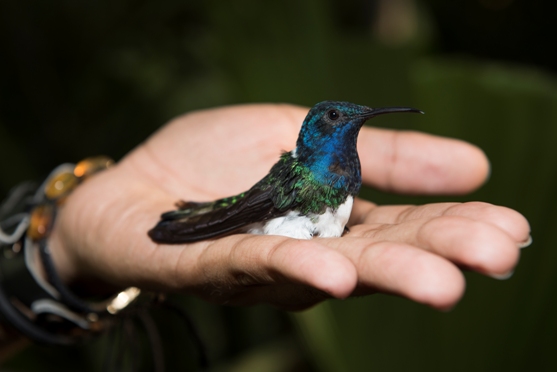Female hummingbirds avoid harassment by looking like males
By Sabrina Imbler
An adult female white-necked Jacobin hummingbird is no stranger to invisible labour.
When she lays an egg, the male hummingbird who played an equal role in the conception of said egg is nowhere to be seen. It is only thanks to her hours of weaving that the egg has a nest at all. When her chick hatches, she alone will feed it regurgitated food from her long bill.
And then there is the constant harassment. As the muted-green females visit flowers to sip on nectar, they are chased, pecked at and body-slammed by aggressive males of their species, whose heads are a flamboyant blue.
But some female white-necked Jacobins, which are found from Mexico to Brazil, have a trick up their wing: Instead of garbing themselves in green plumage, they take on bright blue ornamentation and appear essentially identical to male hummingbirds. Scientists found these male look-alikes avoid harassment directed toward green females, according to a paper published recently in the journal Current Biology.
For the last 50 years, most scientists have relied on the theory of sexual selection, or mate choice, to explain why so many male birds have such foppish traits, such as a peacock’s mirage of tail-feathers or a hummingbird’s sapphire blue head, said Jay Falk, a postdoctoral researcher at the University of Washington and an author of the paper.
But these theories can disintegrate when applied to female birds, which can evolve ornamentation of their own for evolutionary advantages that have nothing to do with seeking male mates.
The white-necked Jacobin weighs as much as a nickel and a penny, and males grow as long as a toilet paper roll. The birds are also hams, often tail-fanning and backflipping to show off.
But their varying colours among females are a long-running mystery.
In 2015, to investigate why the female Jacobins resembled males, Falk went to the town of Gamboa, Panama, one of the hummingbirds’ more accessible haunts.
The blue-headed females clearly enjoyed more personal space, but were there other benefits? Falk monitored the feeding behaviours of green females, blue-headed females and blue-headed males using implanted tracking tags. An analysis of 88,000 feeding visits over nine months revealed the blue-headed females visited feeders more frequently and for longer spells of time than green females.
Forget males; food seems to be the ultimate driver of female ornamentation in white-necked Jacobin hummingbirds.
-New York Times


